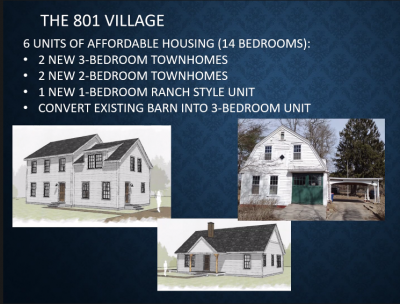Developer seeks funds to build new affordable apartments on Main Street
Voters will decide whether to spend $300,000 of Community Preservation funds to support the effort to build six affordable housing units at 801 Main St., adjacent to the existing Village at 815 Main St. development.
Joan Kinniburgh, chair of the Community Preservation Committee, presented the project to the Select Board on March 22.
She said the project will cost $2.8 million, so the town’s contribution would cover 11% of the budget. The buildings are modular, so with a fall groundbreaking, the units will be open in the spring.
The new units would be managed and maintained by the staff of 815 Main St., a 49-unit affordable apartment complex, and will be built by the same builder, John Scanlan.
The small development is set to be built on a parcel of land that currently hosts a home and barn. The home has been renovated to be affordable, and the barn will be converted to an affordable unit. Those units would be accessed by the current home’s driveway, while the other units would be accessed through the existing 815 Main St. entrance, west of the railroad bridge.
Kinniburgh praised the design, management and maintenance of 815 Main St. The new units will have access to the development’s shared amenities: community center, workout area, playground, basketball court, garden, BBQ grills, and on-site laundry. Pets are welcome.
“This is really a neighborhood that maintains the character of Wareham,” Kinniburgh said.
The new six buildings would contain three three-bed units (one in the barn), two two-bed units and a one-bedroom ADA compliant unit.
The property would have a 40-year affordability deed restriction.
Select Board member Alan Slavin said that he is critical of using community funds to support projects led by for-profit companies, which can earn up to 20 percent on affordable housing projects.
Community preservation funds are collected through a surcharge on property taxes and can only be used for certain purposes: affordable housing, historic preservation or open space and recreation. A certain percentage of the funds must be spent on each use.
“They’re probably going to make at least a half a million dollars no matter what on this project, plus the rental income and whatever else,” Slavin said. He said the town has better uses for those funds than giving them to a company that doesn’t need the money.
Peter Teitelbaum, another board member, said that “whether we like it or not” the town needs to meet the 10 percent threshold of affordable housing to gain more control over such affordable developments.
As long as Wareham’s housing stock is made up of fewer than 10 percent affordable units, it has little recourse to prevent developers building under Chapter 40B rules, which allow them to bypass some local zoning and planning bylaws.
“If we want to get to that 10 percent so that we can start saying no, I think we grab the units that we can, even if it takes throwing a little public money at the issue,” Teitelbaum said.
He also noted that the alternative to partnering with for-profit companies would be through a public agency like the Wareham Housing Authority, which would involve acquiring property.
Board member Patrick Tropeano said he was struck by the 40-year affordability restriction on the deed, and said he wished it would be a restriction in perpetuity. The Village at 815 Main Street, built about a decade ago, has a 30-year affordability restriction that property manager Nanette Perkins said will likely be renewed.














